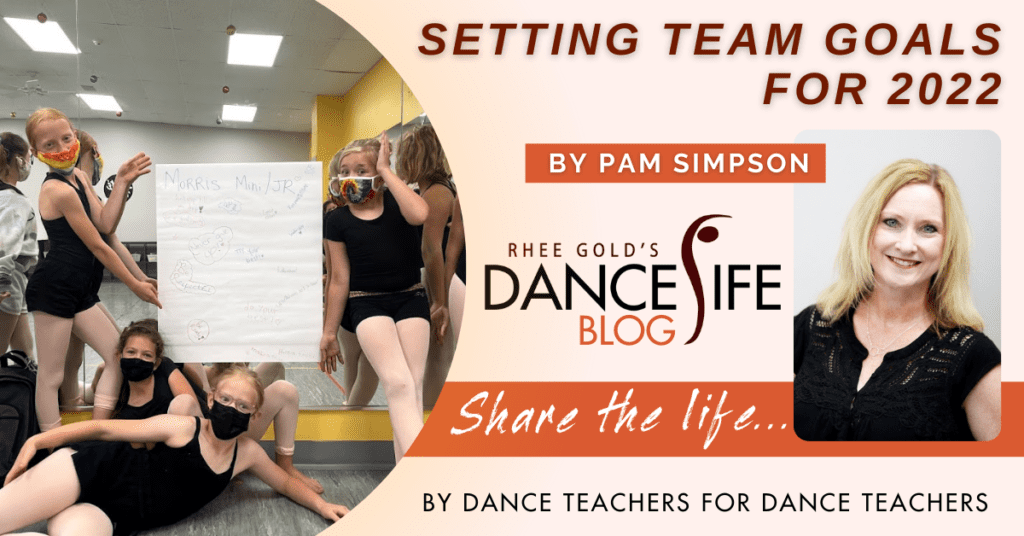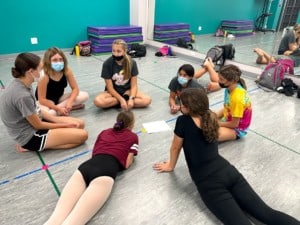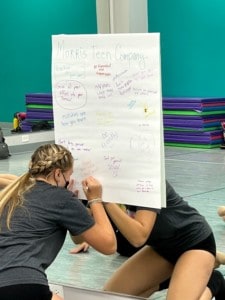Setting Team Goals for 2022

As we prepare for a new year, it is time to do some Goal Setting. Today I am going to discuss four different ways to set your goals for your teams at your studio.
The new generation of students wants to be involved in decisions and work side by side with you. Instead of fighting Gen Z, I say we embrace it and work with them. Last year I decided to ask my advanced tap class to help select the music for their dance. I gave them three choices and let them pick. Now, you might be thinking that is crazy, however, it was one of the best things that I did that year for that group. They felt empowered and more invested in the routine than they had in years past. They had fun with the routine and it had a very successful season. I want to challenge you to find ways to incorporate them into the decisions that you make in 2022.Now, let’s take that same concept and put it on Goals for 2022. Setting goals for your teams is an important part of the process. I always tell my students. “If you don’t know where you are going, you will never get there.” I like to sit my teams down a few times a year to set the goal, review how it is going, and then analyze how they did. If you are not doing this yet, I suggest you start with one goal for each team.
I am going to share four different ways you can set goals with your teams this year. Each one is completely different, but all are effective.
For our entire studio, we do SMART Goals each February. SMART Goals are Specific, Measurable, Attainable, Relative, and Time-Bound Goals. This is where each class sets a specific goal that they want to achieve as a class by April. We give them 8 weeks to achieve the goal. We have the skill selected for each class ahead of time. This is something that the entire class can master with practice.They fill out a SMART Goal sheet together including the Goal, the steps they need to take inside the classroom, and the steps they need to take outside the classroom to achieve the goal. The students are able to contribute what they think they need to do to achieve the goal. It is fun to see them start figuring out how to work towards a goal. I also find it fascinating that 9 times out of 10 will say they need to practice at home every day. (Which we know will never happen.) That is where we have to jump in and help it be realistic.
We revisit this sheet each week for the 8 weeks to help remind them. I like to ask who did the steps on the sheet at the beginning of class. Sometimes I will reward the practicing with stickers to help motivate others in addition to the reward. At the end of the 8 weeks, we do a skills test and celebrate the class as a whole for achieving their goal. They get a prize, we take pictures and post on social media and send home a celebratory email to the families.
For our competitive teams, we did TEAM Goals, with a new approach to their overall goals for the season this year that is working really well. I sat them all down at the beginning of the season and talked to them about having the best year and how it matters that they work as a team. I then asked them to tell me what matters most to them this year for their team. I wanted them to create their own goals for their team in general. What was created was beautiful.
I put up the extra-large post-it notes on the wall and each member came up to the poster and wrote something that mattered to them for the team after they sat in a circle and discussed it. What came out of this was not specific goals, but it was magical. They wrote things like “Always do your best”, “teamwork”, “don’t give up”, “be positive”, “be respectful”, “Leadership”, “acceptance”, “Communication”, and much more. I had a spokesperson for each group stand and declare their goals to their team to get them excited and then ask if there was anything missing. Most of the groups had something to add to their list.
Each team had its own flavor, but there were similarities in the theme for sure. The culture of the studio as well as what was important to the kids came out as they wrote on the posters. We keep the posters hanging in the classroom for each group as a reminder. I also will refer to the posters from time to time when they are doing a great job with one of the goals as well as when they are not.
With competition season around the corner, It is a great time to set COMPETITION Goals as well. I sit
each team down and discuss what they think is important for the season and have them write it on their own goal charts. We set a team goal and I let them pick an individual goal as well. We do this in January and revisit it before and after each competition. For this goal, it is important that it not be tied to a WIN. Help them come up with something specific that they can attain that is not centered around winning. We want to encourage effort and teamwork now more than ever. Be sure to celebrate with them when they achieve their goals and remind them often of the goals and what steps they need to make to achieve the goals.The last goal-setting strategy is the COMPANY Goal This one involves an entire company or competitive team. Many studios have multiple levels in their company like mini, junior, teen, and senior. The goals above are set for individual groups. Another way to go about this is to set a company-wide goal that everyone works towards. We do this by awarding points to the students for things like arriving on time for events, coming prepared, helping a friend, etc. We set a team goal of 500 points and if they achieve the goal, they get a party at the end of the year. To start implementing this, think of a list of things that you would like your students to do during the season. Set up a spreadsheet with each student’s name to track the points. It is amazing to see them all work toward the little goals to earn the party. It also promotes teamwork and responsibility. They help each other out when someone forgets an item, they figure it out so they get the points for being prepared.
All of these goal-setting strategies can be used for your classroom or your teams to help students learn how to set goals and work to achieve them. During the current times, I really feel like our students need this training of goal-setting and life skills along with some positivity. I am happy to share my SMART Goal worksheet with you if you want to email me at
Pamsimpson5678@gmail.com.
Pam Simpson is the founder, president, and driving force behind Forte Arts Center, which was established in Morris, Illinois in 1993. In addition to building her business from a small, one room studio to a large, multi-location organization that offers dance, tumbling and cheer programs as well as private music lessons, Pam is a leading force in the realm of small business ownership in the dance and tumbling industries as she travels all over the country speaking to and educating for large organizations such as Rhee Gold Company, Dance Teacher Summit, and More Than Just Great Dancing. When not working on her businesses, Pam enjoys spending time with her family and visiting her daughter, who is a performer at Walt Disney World.










thanks for sharing an instructive post. SMART goals are possibly the most effective way of focusing attention and making things happen in your business. This article carries an informative content. And you also represented it very impressively.
Great post! I love the idea of setting Simpson goals to stay focused and motivated. The tips are practical and easy to follow.